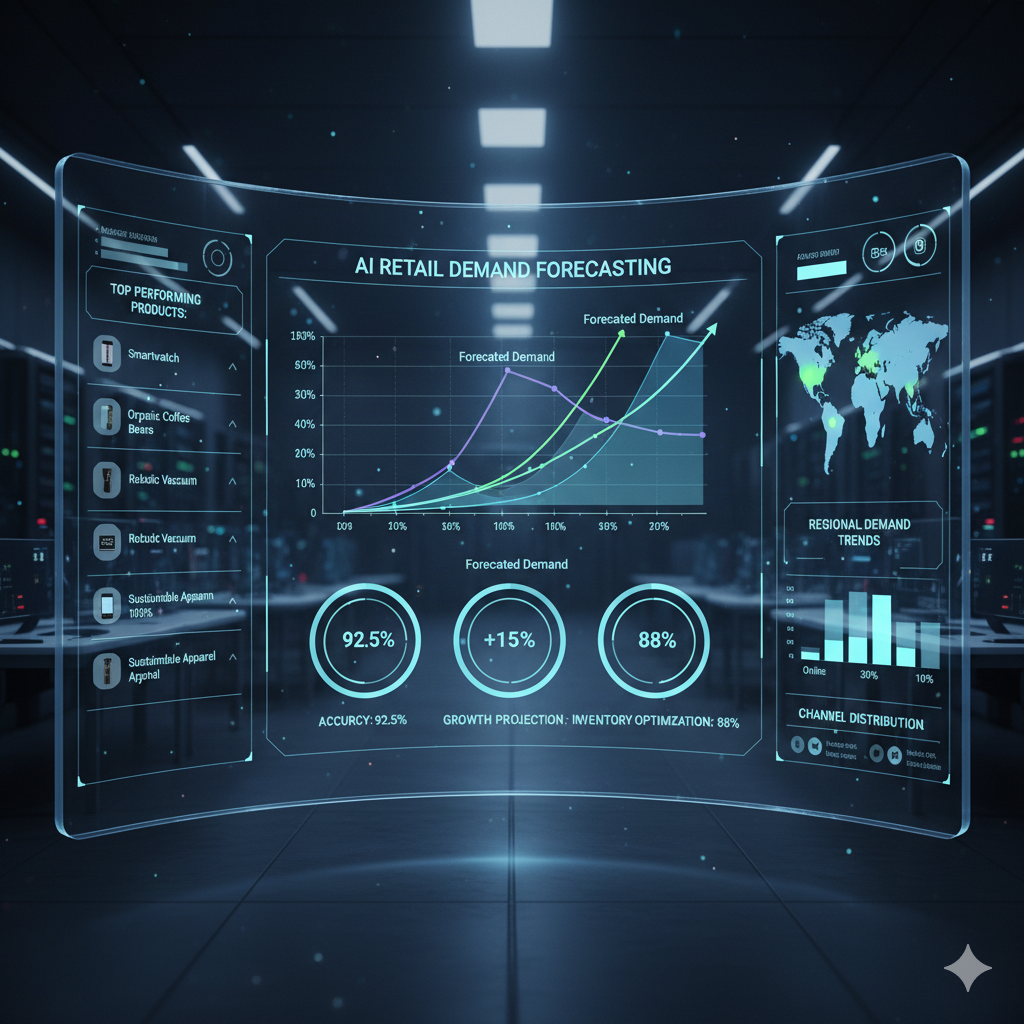Every business with physical inventory faces the same maddening paradox: you’re simultaneously holding too much stock and not enough of what you actually need. Warehouses overflow with slow-moving products tying up precious capital, while your best-sellers run out at exactly the wrong moment, sending frustrated customers to competitors.
This isn’t a minor operational inconvenience, it’s a financial crisis hiding in plain sight. UK businesses collectively hold over £3 billion in excess inventory at any given time, representing dead capital that could fuel growth, innovation, or simply strengthen balance sheets. Meanwhile, stockouts cost retailers an estimated £4 billion annually in lost sales.
The root cause? Traditional inventory management relies on historical reporting and human intuition — essentially driving forward while looking in the rearview mirror. By the time you realize demand is shifting, you’re already carrying the wrong inventory mix.
StockIQ represents a fundamental reimagining of inventory management through AI-powered predictive analytics that doesn’t just tell you what happened last quarter, it tells you what’s going to happen next month, next week, even tomorrow, with remarkable accuracy.
The Inventory Management Trap
Before exploring the solution, let’s examine why inventory management has remained so persistently difficult despite decades of technology investment.
The overstocking spiral. Nobody wants to disappoint customers with stockouts, so the natural instinct is to order generously. But excessive inventory creates a cascade of problems: capital tied up in stock that could fund marketing, hiring, or expansion; warehouse costs escalating to store excess products; product obsolescence as items sit too long and become outdated; and cash flow constraints limiting flexibility and growth.
The stockout nightmare. Order too conservatively and you face different disasters: immediate lost sales when customers can’t find what they want, long-term customer loss as disappointed buyers shift loyalty, emergency reordering at premium prices, and brand reputation damage from unreliable availability.
Complexity explosion. The challenge compounds exponentially with business growth. A retailer managing 50 SKUs faces 50 forecasting challenges. A business with 5,000 SKUs faces an impossible task — no human team can accurately predict demand across thousands of products while accounting for seasonality, trends, competition, weather, local events, and countless other variables.
Traditional tools that don’t solve the problem. Most businesses rely on ERP systems that track what happened but provide little insight into what will happen. These systems might flag that you sold 100 widgets last month, but they can’t tell you whether next month will bring 80 or 150.
StockIQ solves all of these problems through genuinely intelligent prediction rather than simple extrapolation from past data.
Predictive Intelligence That Actually Predicts
The revolutionary aspect of StockIQ lies in how its machine learning algorithms process vastly more information than any human could consider, identifying patterns and relationships that would be impossible to spot manually.

Multi-factor demand forecasting. StockIQ doesn’t just look at your sales history, it synthesizes dozens of data sources to build comprehensive demand models.
- Historical sales patterns reveal baseline demand, while AI identifies subtle patterns like “this product sells better on rainy days” or “demand spikes when a complementary product is promoted.”
- The system monitors weather forecasts and correlates them with past purchase behavior, automatically increasing orders for cold drinks, sunscreen, or fans when heatwaves are predicted.
- Local events integration means StockIQ knows when festivals, sporting events, or concerts will drive temporary demand spikes.
- Economic indicators help predict broader demand shifts, such as slowing luxury item sales when consumer confidence dips.
- Competitor activity monitoring identifies rival promotions so you can anticipate and adjust in advance.
Product lifecycle intelligence. StockIQ recognizes that new, mature, and declining products require different forecasting models and adjusts accordingly.
Supply chain risk prediction. The platform also tracks lead time variations, supplier reliability, geopolitical risks, and raw material shortages to anticipate disruptions weeks in advance.
Continuous learning. Unlike static models, StockIQ learns from actual outcomes, improving forecasting accuracy over time.
Real-World Transformation: A Multi-Store Retailer
A UK retailer operating 12 stores selling home goods and décor — around 3,500 SKUs — experienced major change after adopting StockIQ.
Before StockIQ, three inventory managers manually reviewed reports and adjusted orders monthly. Despite their effort, every holiday season brought chaos: popular decorations sold out early, while others collected dust. Weather swings caused overstocking and shortages in unpredictable ways.
The company held £840,000 in inventory, with 28% being slow-moving stock and 14% average stockouts. Markdown losses ate 18% of gross margin.
After implementing StockIQ, the platform ingested historical sales, weather data, event calendars, and economic indicators. Within weeks, it generated daily forecasts for every SKU and location.
The AI uncovered invisible patterns — pillows sold better during rainy weeks, garden décor demand followed weather forecasts, and stores near universities saw spikes during student move-in.
StockIQ adjusted orders automatically, reducing seasonal décor overstock during warm autumns and reallocating stock near festival sites. When a supplier’s shipping delays arose, the system preemptively boosted orders, preventing any stockouts.

Results
- Working capital in inventory fell by 27% (£226,800 freed).
- Stockouts dropped 70%, boosting sales by 11% through better availability.
- Markdown losses fell from 18% to 7%.
- Inventory turnover improved 38%, ensuring fresher stock and faster cash flow.
The human team now focuses on supplier strategy and product development, while StockIQ handles forecasting precision.
The Human-AI Partnership
StockIQ doesn’t replace humans; it enhances them.
AI manages data-heavy forecasting and continuous monitoring. Humans provide judgment, context, and business strategy. When StockIQ detects something unusual — like an upcoming disruption or surprising demand trend — it alerts managers with clear explanations.
When humans override predictions, StockIQ learns from these decisions and integrates that logic into future forecasts, becoming more aligned with business strategy over time.
Beyond Cost Reduction: Strategic Advantages
While the 20–30% inventory cost reduction is impressive, the bigger benefits are strategic:
- Cash flow transformation: Less capital tied in stock means more flexibility and growth funding.
- Competitive advantage: Better availability drives loyalty and repeat customers.
- Rapid adaptability: Detect demand shifts faster than competitors.
- Scalable growth: Manage more products or stores without hiring more planners.
- Sustainability: Less waste, lower carbon footprint, and reduced disposal costs.
The Future of Inventory Management
Traditional methods of managing inventory through human intuition and spreadsheets are becoming obsolete. AI-driven systems like StockIQ provide precision, adaptability, and continuous improvement.
Businesses adopting AI inventory optimization early will gain compounding advantages: better stock efficiency, stronger margins, and loyal customers. Those clinging to outdated methods will lag behind competitors that move faster and operate leaner.
The Decision Point
For businesses evaluating StockIQ, the question isn’t whether AI-powered forecasting delivers value — it clearly does. The real question is strategic:
Can you afford to keep tying up 25% more capital in unnecessary stock?
Can you compete effectively when rivals always have what customers want?
Can you grow if inventory complexity limits expansion?
StockIQ is turning inventory management from a burden into a strategic advantage. In a world where operational precision defines success, the future belongs to those who can predict and adapt.
Your inventory is either optimized by AI, or you’re competing against someone’s that is.
The only question is which side of that divide you’ll occupy.

